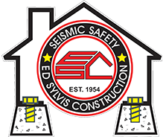It’s common knowledge that engineers have to put a lot of thought into creating earthquake-resistant constructions. Reviewing the basics can make the reasons clearer.
How Do Earthquakes Work?
Earthquakes happen when rocks in Earth’s crust suddenly slip and slide against one another releasing massive energy. This energy creates seismic waves, which can cause the ground to move, sometimes mildly, and sometimes with destructive force.
Seismic waves can be divided into two categories: body and surface. Body waves go through the planet’s interior and are followed by surface waves that move the ground. Surface waves are the culprits behind the ground shaking, and thus the reason behind most earthquake hazards.
Geologists refer to these surface waves as Love (the one that moves horizontally) and Rayleigh (the one that moves both horizontally and vertically) waves.
What Are The Earthquake Hazards?
Buildings don’t tend to suffer a lot of damage when an earthquake moves vertically under the ground, because they’re naturally designed to withstand vertical forces to a reasonable extent.
It’s the Love waves – extreme horizontal rolling waves – that cause lateral accelerations that spell trouble.
To illustrate with a simple example, to cause an acceleration of 1G a quake of 6.7 magnitudes would be required. This acceleration could produce a 40-inch peak velocity per second. It’s a building-equivalent of someone unexpectedly violently shoving you.
High magnitude acceleration can be an enormous stress on structural integrity. It would put all structural elements (floors, walls, columns, beams, etc.). Depending on how violent that stress is, the damage can range from crippling damage to collapse.
It should also be not be forgotten that the substrate the structure was built on can have a crucial role in how the building in question withstands the earthquake. Bedrock, for example, can withstand a lot due to firmness. Soft or filled-in soil doesn’t have this advantage, and thus the buildings are more vulnerable to damage.
Liquefaction is commonly considered to be the greatest risk. It’s when loose, waterlogged soil slides or sinks, taking the buildings along.
What Goes Into Earthquake Hazard Reduction?
Existing structures can be modified and made more resistant to seismic hazards using several techniques. This is called seismic retrofitting.
The techniques include decoupling the hazardous structure from the shaking ground to protect its integrity (base isolation), putting dampers on structures to absorb motion energy, using external post-tensioning on buildings to create a moment-resisting system, etc.
Foundation repair is another way to reduce earthquake hazards, as it’s a common seismic weakness. Concrete foundations, in particular, can be vulnerable as they don’t have enough strength to resist earthquakes, so occasional repair and replacement jobs may be necessary.
In Los Angeles, there’s a state-sponsored program called Earthquake Brace and Bolt. Under the program, the state provides funding for an approved contractor to perform anchor bolting and bracing.
How To Make You Building Earthquake-Resistant?
If what you’ve learned from this article has motivated you to reduce potential hazards caused by earthquakes Seismic Safety can help! Seismic Safety has over 50 years of experience handling foundation issues, and whether you’re looking for assistance with a seismic retrofit job, earthquake-resistant foundation building, or foundation repair in Los Angeles, Seismic Safety can provide what you need with ease.

